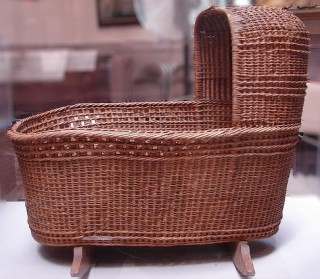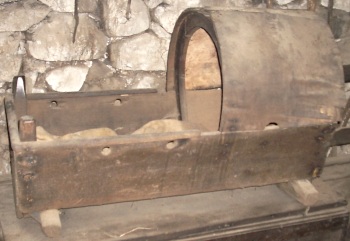
Cradle designs have changed, but are parents’ concerns any different? 200 years ago people were writing about the well-known dilemma: how much can I let my baby sleep in the day without stopping it from sleeping well at night?
It only remains…to say something of the cradle…I believe there is no doubt but the custom of laying children down awake, and rocking them in a cradle in the day time, or…in the evening when they are to go into their night’s sleep, as it is called, may [make] them sometimes more wakeful in the night… From: A Treatise on the … Management of Infants, 1784*

Two of the cradles pictured on this page are 300-400 years old, but they look much the same as cradles from only 100 years ago. For centuries, babies in Western Europe and North America were put into small baskets or boxes raised slightly off the floor, on rockers, with or without a hood. Rocking cradles like these have gone out of fashion, and we have different customs now.
Rockers, hoods, drapes, handles, straps
Babies could be strapped in, either with strips of cloth tied right round the whole thing, threaded through holes, or attached to wooden knobs or basketry handles. The child was protected from draughts and damp floors, especially in a hooded cradle. Wicker cradles often had fabric drapes over the hood for extra warmth and daytime darkness.

A small cradle can be rocked by an older sibling or a busy adult with a foot to spare for rocking while her hands are busy with other tasks. It can be lifted to another place using handles or convenient bits of wood-carving. Overall, the baby was fairly safe but questions remain. Was it left alone? What about mice in a world without chemical pest control? Would a busy carer tie the baby in and neglect it?
I had made it an invariable rule always to dress and undress my infant, never suffered it to be placed in a cradle, nor to be fed out of my presence. A basket of an oblong shape with four handles (with a pillow and a small bolster) was her bed by day: at night she slept with me. I had too often heard of the neglect which servants show to young children, and I resolved never to expose an infant of mine either to their ignorance or inattention. From: Mrs. Robinson’s Memoirs, looking back at the 1770s*

Materials and styles varied regionally, though the basics stayed the same. Planks of wood from big trees were available inmuch of Britain and Scandinavia. Numerous paintings of Dutch domestic life confirm that wicker cradles were common in the Netherlands. Cradles were ornamented with colourful folk art in areas with strong traditions of painting on wooden furniture.
Natural rocking
The last word goes to the 18th century “expert” quoted earlier:

I cannot help thinking, there is something so truly natural, as well as pleasant, in the wavy motion of a cradle, and so like what children have been used to before they are born, ….that, always wishing to follow nature as I do, I cannot, on the whole, but give an opinion rather in favour of the cradle. From: …Management of Infants, 1784*
Notes
* Michael Underwood, A treatise on the diseases of children, with directions for the management of infants from the birth; especially such as are brought up by hand, London 1784
* Memoirs of the late Mrs. Robinson, written by herself. With some posthumous pieces. Edited by her daughter, M. E. Robinson, London 1801
* More about the American wicker cradle picture here.
Photos
Photographers credited in captions. Links to originals here:
Dutch-American wicker cradle, Swedish cradle.
More picture info here
//
http://pagead2.googlesyndication.com/pagead/show_ads.js
I have a wicker rocking cradle that was my grandmother’s and would have been made in the 1800’s if it was purchased new. It is on tall legs and has lots of scroll work. The tops of the leg pieces are also decorated with scroll work. The cradle itself is fairly large. I have been unable to locate anything like it on-line. However, I opened an older quilting book yesterday and low and behold there was one just like it.
Any help you could give me about its origin or worth would be great.
LikeLike
Hi -Your cradle sounds wonderful. Amazing to suddenly see its twin in a book like that! I wish I could help, but you would be better showing it (or photos of it) to a museum or antiques dealer and telling them the name of the book you saw it in. It would be great if this led to more info for you. Good luck!
LikeLike
I love wooden rocking cradles, as well as wooden furniture…that’s just how I roll I guess!
Thanks for the post and history lesson 🙂
LikeLike
I would be very interested to know more about the 17C style Oak Cradles – do they have a value? Where do you look to purchase/sell them?
LikeLike
I have a old cradle I just bought and I’m trying to find out how old is it is there a way for me to find out
LikeLike
love this page I am restoring a Victorian rocking crib with hood in pine not sure how to curve the replacement wood needed for the hood
LikeLike
nice words man
LikeLike